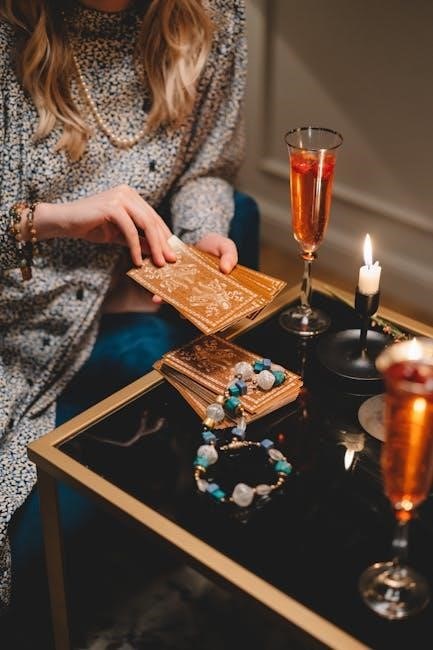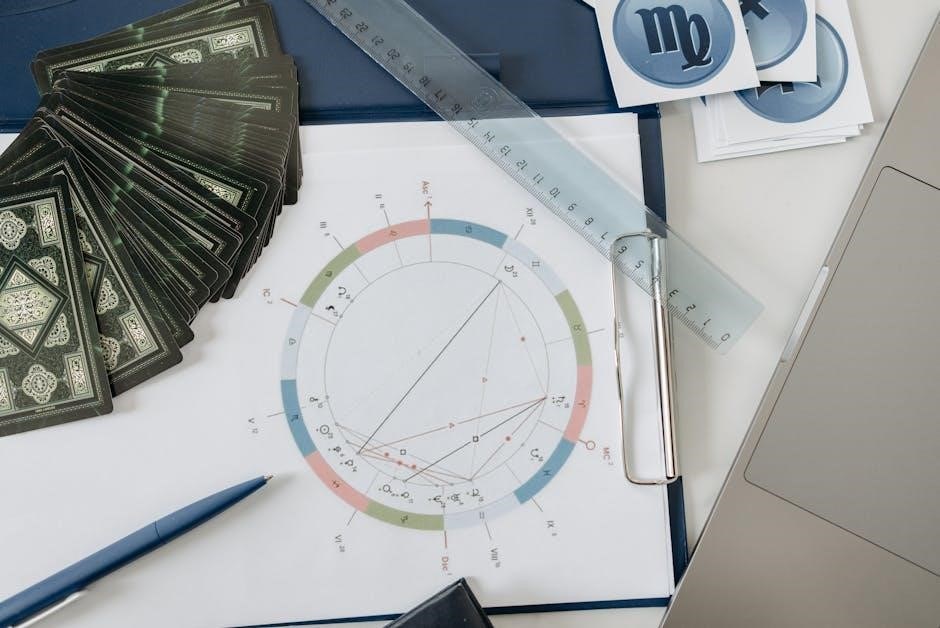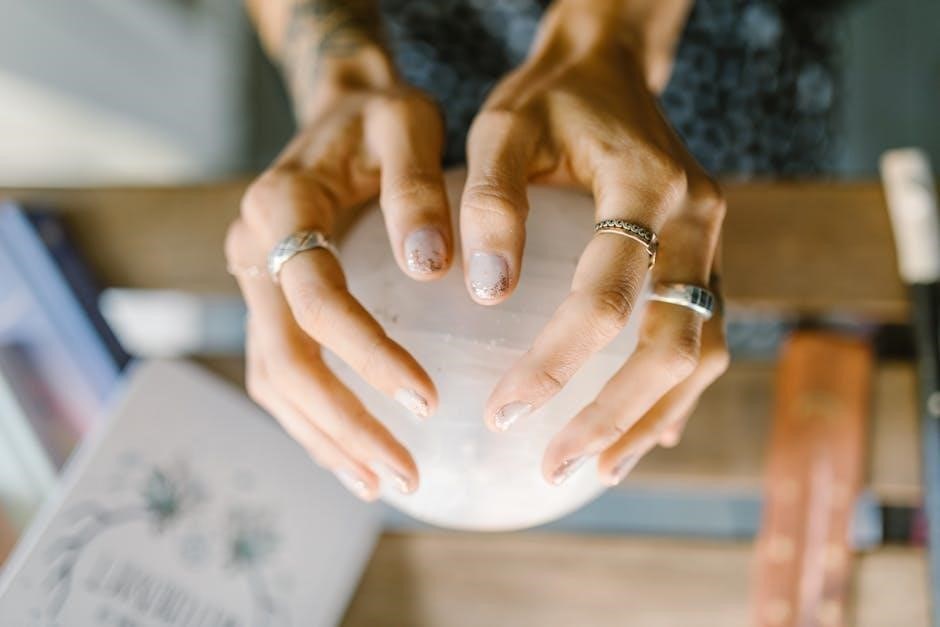Tarot reading is a powerful tool for self-discovery, intuition, and gaining insights into life’s challenges. It involves interpreting symbolic cards to uncover hidden meanings and guide decision-making. Anyone can learn tarot, regardless of psychic ability, by understanding card symbolism and trusting intuition. With countless resources like PDF guides and online tutorials, mastering tarot has never been more accessible. Embark on this journey to unlock the secrets of the cards and deepen your connection to yourself and the world around you.
What Tarot Cards Are and How They Work
Tarot cards are a deck of 78 cards, divided into the Major Arcana and Minor Arcana, each carrying symbolic imagery and meanings. The Major Arcana represents major life themes and transitions, while the Minor Arcana reflects everyday situations and emotions. The cards work by tapping into intuition, allowing readers to interpret their symbolism and connect with the querent’s energy. They serve as tools for self-reflection, guidance, and exploring possibilities, not as predictors of a fixed future. Understanding their meanings and trusting your intuition is key to harnessing their power.
Common Myths About Tarot Cards
Tarot cards are often misunderstood, with myths surrounding their use. Many believe you must be psychic or that decks should be gifted, but neither is true—anyone can learn tarot. Contrary to popular belief, tarot cards are not inherently magical or evil; they are simply tools for self-reflection. Their power lies in the reader’s intuition and ability to interpret symbolism. Debunking these myths allows learners to approach tarot with an open mind, focusing on its true purpose: guidance, introspection, and personal growth.
Choosing Your Tarot Deck
Selecting a tarot deck is a personal journey. Choose one that resonates with you intuitively, whether through its artwork, theme, or energy. Trust your connection to the deck.
How to Select the Right Tarot Deck for You
Choosing the right tarot deck is a deeply personal process. Trust your intuition and select a deck that resonates with you aesthetically and energetically. Consider the artwork, theme, and symbolism that speak to your soul. Browse various decks, read reviews, and explore their unique styles. Whether it’s a traditional or modern design, the most important factor is your emotional connection to the cards. Remember, you can purchase your own deck—there’s no rule requiring it to be gifted. The right deck will feel like an extension of yourself.
Clearing and Charging Your Tarot Cards
Clearing and charging your tarot cards ensures they resonate with your energy, enhancing their accuracy and connection. Start by shuffling the deck to remove stagnant energy. Smudging with sage or palo santo is a popular method to purify the cards. Place them under moonlight or hold them in your hands, focusing on your intention. Some people also use crystals or sea salt for cleansing. Regularly clearing and charging your deck helps maintain its clarity and alignment with your intuition, making readings more meaningful and personal.

Understanding the Structure of the Tarot Deck
The tarot deck contains 78 cards, divided into the Major Arcana and Minor Arcana. The Major Arcana represents life’s major themes and transitions, while the Minor Arcana reflects everyday situations. Each suit in the Minor Arcana—Wands, Cups, Swords, and Pentacles—symbolizes elements of life, such as creativity, emotions, challenges, and material wealth. Court Cards portray personalities or roles, adding depth to readings. This structure provides a comprehensive framework for exploring past, present, and future.
The Major Arcana Cards
The Major Arcana consists of 22 cards, each representing significant life themes, spiritual lessons, and major transitions. Cards like The Fool, The Magician, and The High Priestess symbolize universal archetypes and experiences. They depict journeys of self-discovery, major decisions, and transformative events, offering deep insights into one’s path. These cards are rich in symbolism, guiding readers through profound moments of growth, challenge, and enlightenment. They highlight pivotal points in life, helping to uncover hidden truths and align with one’s purpose.
The Minor Arcana Cards
The Minor Arcana consists of 56 cards, divided into four suits: Wands, Cups, Swords, and Pentacles. Each suit reflects aspects of daily life, with numbered cards (1-10) representing everyday challenges and opportunities. The Court Cards (Page, Knight, Queen, King) depict personalities or roles influencing a situation. Together, they provide insight into mundane concerns, emotions, conflicts, and material affairs, offering practical guidance for navigating life’s smaller yet significant moments. Understanding these cards helps readers connect with the subtler details of their experiences and decisions.
The Court Cards
Court Cards—Page, Knight, Queen, and King—represent personalities, roles, or energies in a situation. Each suit (Wands, Cups, Swords, Pentacles) has its Court, reflecting different traits. Pages symbolize messages or new beginnings, Knights embody action and adventure, Queens nurture and wisdom, while Kings signify leadership and mastery. These cards can represent individuals in your life or aspects of yourself, offering insights into human dynamics and personal growth. Interpreting them involves understanding their roles and how they influence the reading’s context.
Basic Tarot Meanings
Tarot cards symbolize life experiences and functions, each with unique symbolism. Understanding their meanings aids in interpreting readings, helping you connect with their deeper messages intuitively.
Understanding Tarot Symbolism
Tarot symbolism is the heart of meaningful readings, connecting cards to universal themes and personal experiences. Each symbol, like stars, swords, or cups, carries specific meanings, guiding intuition. Colors, numbers, and imagery evoke emotions, while recurring motifs, such as nature or archetypes, offer deeper insights. By decoding these symbols, readers tap into subconscious wisdom, uncovering hidden patterns and truths. This intuitive language helps bridge the conscious and subconscious, making tarot a powerful tool for self-reflection and guidance. Mastering symbolism enhances your ability to interpret cards with clarity and precision, enriching every reading.
The Suits and Numbers in the Minor Arcana
The Minor Arcana consists of four suits—Wands, Cups, Swords, and Pentacles—each representing different aspects of life. Wands symbolize creativity and energy, Cups reflect emotions and relationships, Swords relate to thoughts and conflicts, and Pentacles connect to material wealth and practicality. Numbers within each suit hold specific meanings: Aces signify new beginnings, while numbered cards (2-10) depict progression and challenges. Court cards—Page, Knight, Queen, King—represent people or personality traits, offering layered insights into situations. Understanding these elements enhances your ability to interpret the Minor Arcana effectively, providing a foundation for deeper tarot insights.
Interpreting Card Positions in a Spread
Each position in a tarot spread holds specific significance, guiding the interpretation of the cards. For instance, in a three-card spread, the first card often represents the past, the second the present, and the third the future. The Celtic Cross spread, with its ten positions, offers deeper insights into various aspects of a situation, such as challenges and future influences. Intuition plays a crucial role, as the imagery and symbolism of the cards must align with the position’s theme. Beginners may start with simpler spreads to build confidence and gradually explore more complex layouts. Additionally, understanding how the suits and numbers in the Minor Arcana align with specific positions can enhance readings, as Wands may signify creativity in the ‘challenge’ position. Court cards often represent individuals or personality traits, adding layers to interpretations. Developing intuition through practice and journaling helps refine the ability to connect card meanings with their positions. Considering reversals can add depth, but mastering upright meanings first is advisable for newcomers. Ultimately, interpreting card positions is about synthesizing symbols, themes, and personal insights to reveal meaningful answers.

Preparing for a Tarot Reading
Setting clear intentions is crucial for a meaningful tarot reading. Create a quiet, sacred space to enhance focus. Shuffle the cards with purpose, infusing them with your energy. Trusting your intuition ensures accurate interpretations. Clearing and charging your deck beforehand enhances the connection. A calm mind and open heart are essential for receiving guidance.
Setting Your Intention for the Reading
Setting a clear intention is vital for a focused tarot reading. Define your purpose, whether seeking guidance, clarity, or self-reflection. Center yourself with deep breaths or a moment of silence. This practice ensures the reading aligns with your goals. A well-defined intention helps filter distractions, allowing the cards to address your specific needs. Trust your intuition and approach the reading with an open, non-judgmental mindset. This intentional focus enhances the accuracy and relevance of the insights you receive from the tarot cards.
Creating a Sacred Space for Reading
Creating a sacred space enhances your tarot reading experience by fostering a calm and centered environment. Choose a quiet, comfortable area free from distractions. Cleanse the space with sage, incense, or a protective prayer to clear negative energy. Use a dedicated cloth or mat for your tarot cards to create a ritualistic feel. Adjust lighting and play soothing music to set a peaceful ambiance. This intentional setup helps you connect deeply with the cards, ensuring a meaningful and focused reading session.
Shuffling and Cutting the Cards
Shuffling the tarot cards mixes their energy and ensures a random, unbiased order. Hold the deck firmly and shuffle with intention, focusing on your question or purpose. You can use an overhand shuffle or riffle shuffle, whichever feels natural. Once done, cut the deck with your non-dominant hand to create a clean separation. This step symbolizes setting boundaries and preparing the cards for interpretation. Remember, there’s no right or wrong way to shuffle or cut—trust your instincts and let the cards respond to your energy.

Conducting a Tarot Reading
Conducting a tarot reading involves setting an intention, laying out cards in a chosen spread, and interpreting their meanings. Trust your intuition to connect with the cards’ symbolism and uncover insights. This process helps guide decision-making and self-reflection, offering clarity and deeper understanding of life’s situations.
Laying Out the Cards
Laying out the cards is a deliberate process that sets the foundation for a meaningful tarot reading. Choose a spread that aligns with your question or intention, such as a simple three-card spread or a more complex Celtic Cross. Shuffle the cards with focus, then carefully place each one in its designated position. Trust your intuition as you arrange the cards, allowing their symbolism to resonate with your energy. This step is crucial for creating a visually and energetically coherent reading that offers profound insights.
Interpreting the Cards
Interpreting tarot cards involves connecting with their symbolism, imagery, and position in the spread. Begin by reflecting on the card’s visuals and intuitive feelings they evoke. Consider the card’s meaning within the context of the question and its placement in the spread. Combine logical analysis with personal intuition to weave a narrative. Pay attention to recurring themes or patterns, as they often emphasize key messages. Trust your inner wisdom to decode the cards, allowing their insights to guide you toward clarity and understanding in your reading.

Trust Your Intuition
Trusting your intuition is essential for meaningful tarot readings. Allow your inner voice to guide your interpretations, as tarot is deeply personal. Take time to reflect on the imagery and sensations each card evokes. Don’t rely solely on manuals—trust your gut feelings and unique insights. Intuition grows with practice, helping you connect deeply with the cards. Remember, there’s no right or wrong interpretation, only the wisdom your inner self reveals through the cards. Embrace this connection to unlock the full potential of tarot reading;

